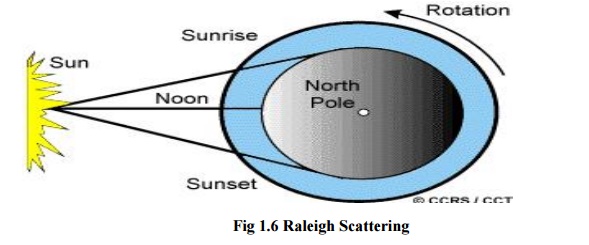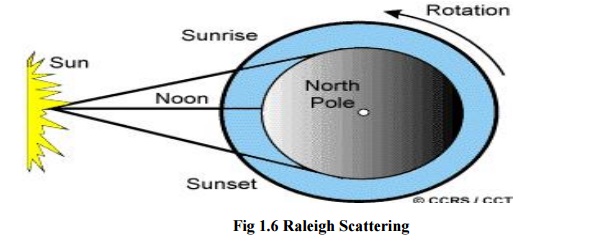Chapter: Civil : Remote Sensing Techniques and GIS : EMR and Its Interaction With Atmosphere and Earth Material
Energy Interactions With The Atmosphere

ENERGY INTERACTIONS WITH THE ATMOSPHERE
Before radiation used for remote sensing reaches
the Earth's surface it has to travel through some distance of the Earth's
atmosphere. Particles and gases in the atmosphere can affect the incoming light
and radiation. These effects are caused by the mechanisms of scattering and
absorption .
1 SCATTERING
Scattering occurs when
particles or large gas
molecules present in
the atmosphere interact
with and cause
the electromagnetic radiation to be redirected from its original
path. How much scattering takes place
depends on several factors
including the wavelength
of the radiation, the abundance of
particles or gases, and the distance the radiation travels through the
atmosphere. There are three (3) types of scattering which take place.

2 RAYLEIGH
SCATTERING
Rayleigh scattering occurs when particles are very
small compared to the wavelength of the radiation. These could bearticles such
as small specks of dust or nitrogen and oxygen molecules. Rayleigh scattering
causes shorter wavelengths of energy to be scattered much more than longer
wavelengths. Rayleigh scattering is the dominant scattering mechanism in the
upper atmosphere.The fact that the sky appears "blue" during the day
is because of this phenomenon. As sunlight passes through the atmosphere, the
shorter wavelengths (i.e. blue) of the visible spectrum are scattered more than
the other (longer) visible wavelengths. At sunrise and sunset the light
has to travel farther through the atmosphere than at midday and the scattering
of the shorter wavelengths is more complete; this leaves a greater proportion
of the longer wavelengths to penetrate the atmosphere.

3ABSORPTION
Absorption is the other main
mechanism at work when electromagnetic radiation interacts with the atmosphere.
In contrast to scattering, this phenomenon causes molecules in the atmosphere
to absorb energy at various wavelengths. Ozone, carbon dioxide, and water vapor
are the three main atmospheric constituents which absorb radiation. Ozone
serves to absorb the harmful (to most living things) ultraviolet radiation for
the sun. Without this protective layer in the atmosphere our skin would burn
when exposed to sunlight. Carbon dioxide referred to as a greenhouse
gas. This is because it tends to absorb radiation strongly in the far infrared
portion of the spectrum - that area associated with thermal heating - which
serves to trap this heat inside the atmosphere. Water
vapour in the atmosphere absorbs much of the incoming longwave
infrared and shortwave microwave radiation (between 22?m and 1m). The presence
of water vapour in the lower atmosphere varies greatly from location to
location and at different times of the year. For example, the air mass above a
desert would have very little water vapour to absorb energy, while the tropics
would have high concentrations of water vapour (i.e. high humidity).
4 MIE SCATTERING
Mie scattering occurs when the
particles are just about the same size as the wavelength of the radiation.
Dust, pollen, smoke and water vapour are common causes of Mie scattering which
tends to affect longer wavelengths than those affected by Rayleigh scattering.
Mie scattering occurs mostly in the lower portions of the atmosphere where
larger particles are more abundant, and dominates when cloud conditions are
overcast.
The final scattering mechanism of
importance is called nonselective scattering. This occurs when the
particles are much larger than the wavelength of the radiation.
Water droplets and large dust particles can cause
this type of scattering. Nonselective scattering gets its name from the fact
that all wavelengths are scattered about equally. This type of scattering
causes fog and clouds to appear white to our eyes because blue, green, and red
light are all scattered in approximately equal quantities (blue+green+red light
= white light).
Related Topics